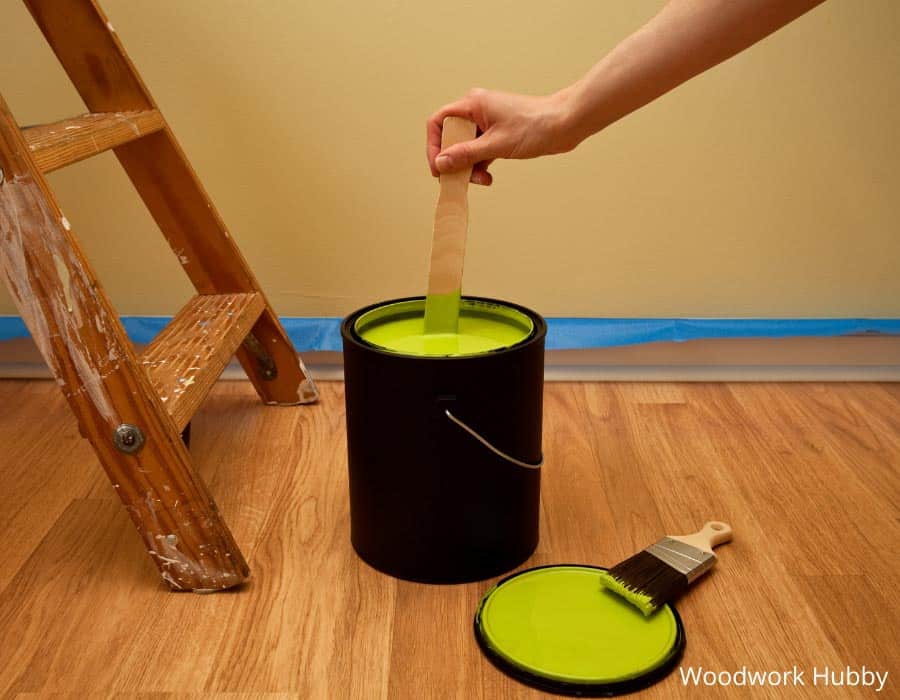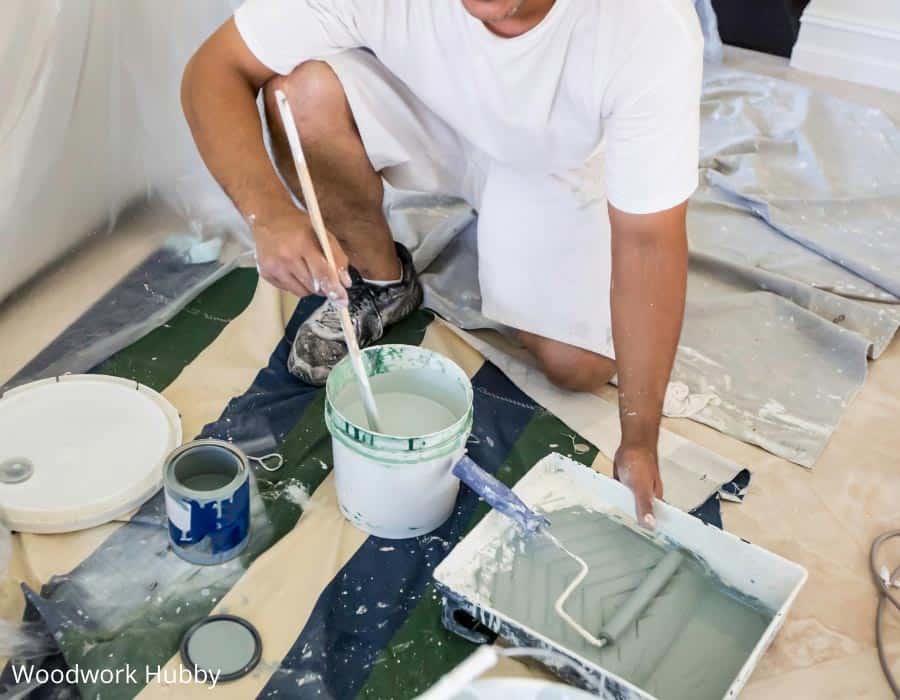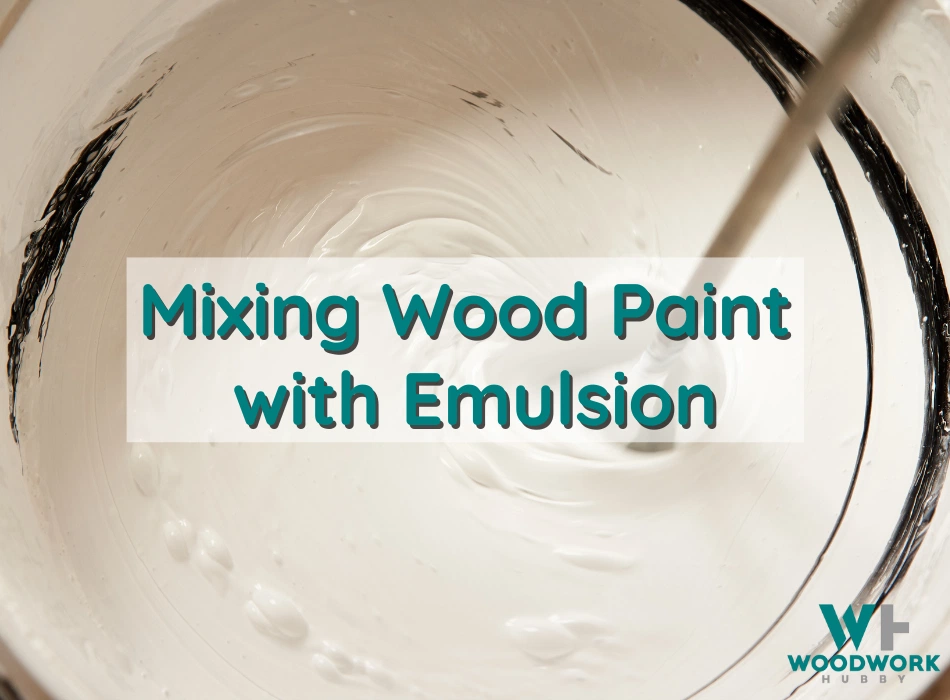After painting there is always a question of what to do with the leftovers. You can keep a quart of paint for touch-ups, for instance, or water up a little emulsion to paint with for sealant before a proper coat. There is another option, however, that you might be considering. Can you mix wood paint with emulsion?
Wood paint can be mixed with emulsion provided both paint and emulsion are a compatible composition of either water or oil-based. If the wood paint is water-based, it needs to be mixed with water-based emulsion.
Emulsion is essentially a suspension of chemical globules in a water-base and when mixing paints you need a medium with a compatible composition. Simply put, water-based paints may be mixed with other water-based paints, oils with oils, and so on.
Today I’m going to talk about mixing wood paint with emulsion, first by telling you a little more about emulsion so that you understand it at a core level and then we’ll focus on proper mixing and a few tips for getting the most out of your paints.

Let’s start with a closer look at Emulsion.
What Is Emulsion Paint At A Granular Level?
Without going overboard on the details, Emulsion is a water-based paint that has had resins added to it, such as acrylic or vinyl, which give it a distinctive sheen when it dries. This is used in the house interior, typically for ceilings or walls, but other applications are certainly viable. Common Emulsion sheen effects include:
- Silk – Great for use in areas that are hot or humid, a silk emulsion provides a hardwearing, high-sheen finish.
- Satin – More hardwearing than matt, Satin emulsion provides a very soft sheen once it is dried.
- Matt – Not as scratch-resistant as the glossy finish, a Matt finish is simply a non-shiny finishing emulsion that may be applied.
These are just a few examples, of course, in order to get us started.
Now let’s say that we’ve got some leftover paint and emulsion, both water-based, and we wish to mix them so that we can have a particular color that will apply and dry with a glossy finish. It should be a matter of just mixing them right up but we want to make sure that we do it properly. You will want to get the following items ready:
- 1 paint can opener
- 1 or more pieces of ‘test wood’
- A few clean paint brushes
- A long stick for stirring the paint thoroughly
- Newspaper to lay out
- Paper towels for inevitable messes
- Empty containers for storing your new mixes
- Small plastic trough like you’d use with a paint roller
- Your leftover emulsion and the paints you are considering mixing with it
Once you mix your paint, have you ever wondered if you can use wall paint on wood?
Mixing Emulsion And Paint: Prepping Your Paints
The mixing part of the paint is easy and most of the work is making sure that your leftover paints which you wish to mix with the emulsion are still good.
First off, if you’ve opened an old can of paint in the color that you’d like to mix with the emulsion you will want to give it a good stir. Always stir with a flat broad stirring stick to get the best results.
If you got some gunk in there, that is okay, as you strain it if you need to. This gets it good and mixed and should let us know if it has gone bad… we should be fine if it hasn’t dried out or gone moldy. If it is a bit chunky then it may need to be strained so let’s go over that process really quick before we proceed.
Straining Paint To Get More Mileage Out Of It
If the paint that you wanted is about 5 years old and still chunky after you’ve mixed it then straining it can rejuvenate your paint and save you a trip to the store. It’s a simple process that just requires an empty plastic container and some cheesecloth or a ‘pro’ paint strainer that you can get from the hardware store. Here is what you do:
- If you haven’t opened the old can yet, do so before shaking it up so that you can clean some of the gunk out of the top instead of mixing it into your paint.
- Stretch your cheese cloth or your paint strainer over your container. You might need some large rubber bands to secure it if nothing else is handy.
- Give your paint a very light mix. You can mix it more thoroughly when we’re done but for now we are just ‘loosening it up’
- Pour it slowly through your makeshift filter
- When the can is empty, discard the gunk on top of your straining filter and give your ‘new’ paint a mix. This is ready now to mix with your emulsion.
Pro tip: This process is one to keep, as you can get new life out of the majority of those old paint cans that you’ve got stored in the garage. Save yourself a little money (for more tools, of course) by straining your old paint and using what you’ve got instead of adding to that pile of half-cans you’re building. You’d be surprised what you’ll save with this simple trick.
Mixing Emulsion And Paint: The Actual Mixing

The actual mixing of your paint is simply a process of trial and error. You can start by putting some paint in one of your empty containers. If this is an empty, clean paint can then this ideal as you will want to have an idea of the volume.
Fill up two containers halfway-up with your wood paint and this way you can experiment with different percentages of emulsion. Try adding light emulsion to one and a heavier concentration in another. Mix thoroughly with your stick and brush a sample of each on your test wood. This will show you if you’ve got the desired color at the level of gloss that you are looking for.
It’s really just a matter of trial and error but if you’ve been painting for a while then mixing paints is nothing new. For those of you out there who are novices, don’t worry, it becomes quite intuitive very quickly. Once you have found the combination of emulsion and paint that you like best then be sure to make a little extra in case you need to do some touch-ups later.
Also, if you are mixing and ending up with a clumpy mess then you may have accidentally gotten one of your oil-based colored paints. These will not mix so you want to make sure that you are only mixing together water-based paints with your Emulsions.
Emulsion Mix Tips To Get The Most Out Of Your New Paints
Mixing up your emulsion with your leftover paints is easy and gets you some really amazing colors for your work. Now that you know the basics we’ve got a few tips that can help you to make the most of your mixing. They are as follows:
- Shiny and Flat do mix – Matt and shiny or glossy mixes can produce some interesting results, giving you a solid color with a soft sheer or more aggressive, shiny colors. Experiment with these two seeming-opposites and you might get some combinations you’ll want to keep.
- Stock up on white paint – You’ll be using a lot of white paint to lighten colors up so when you are at the hardware store be sure to watch for sales. An extra can here and there can come in handy when you’ve got a big project and need to mix up one of your signature colors.
- Making it brighter is harder than making it darker – Save yourself some time and cursing when it comes to lightening a color that you like. Start with a base of a half-can of white paint and slowly add your darker color. Mix and then start adding your emulsion when you’ve got the color that you like.
- Get some 5-gallon buckets – When you find a color and finish combination that you really like, don’t hesitate to make up a large batch that you can store away for later. If you do a lot of painting it’s useful to have some batches pre-mixed and they’ll hold up just fine in the garage. Just mix thoroughly before you use it again like any other paint.
- Take notes so that you don’t forget – A small notebook that you can get for less than $2 is a great way to record what you’ve mixed for those times when you get a color and gloss that you really like from your paint and emulsion mixing. Write down the percentage of emulsion vs. paint so that you can reproduce your favorite mixes at any time instead of having to find them again.
Can You Mix Wood Paint With Emulsion? You Bet You Can!
Today we’ve discussed mixing wood paint with emulsion and as you can see, with both mediums being water-based, it is simply a matter of preparing your paints and finding the ratio of color and sheen that you like.
With a little experimentation you can come up with some signature colors that will compliment your woodwork – just don’t forget them to write down the good ones.
You don’t want to be spending all Sunday trying to get that color exactly right again!




